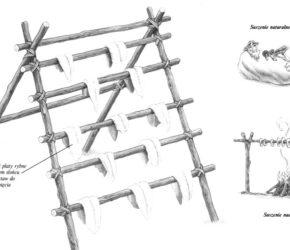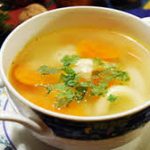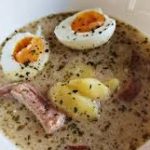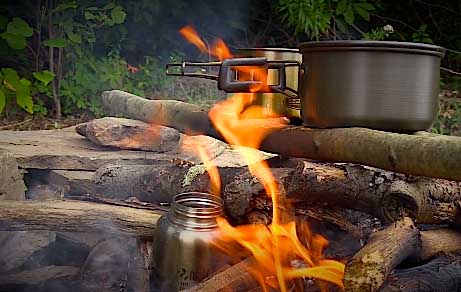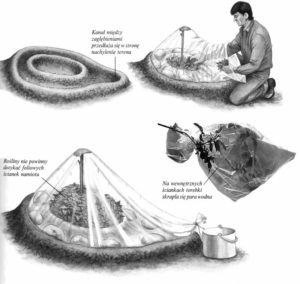Żywność zabierana na wyprawę to zwykle konserwy i torebki z odwodnionymi proszkami naturalnymi. Niektóre produkty są w postaci naturalnej, tak zwany suchy prowiant. Jedzenie w konserwach jest ugotowane i nadaje się od razu do spożycia na zimno lub ciepło. Konserwy zajmują sporo miejsca i są bardzo ciężkie. Odwodnione proszki zaś, na przykład zupy w torebkach, są lekkie i łatwiejsze do zapakowania, ale wymagają dodania duże ilości wody. Na niektórych terenach może okazać się, że musisz dźwigać ze sobą dużo wody tylko po to, by ugotować zupę z torebki. Nie zjadaj jednak jedzenia w proszku bez wody; absorbuje ono wodę z organizmu, co może być przyczyną złego samopoczucia, kłopotów z trawieniem i groźnych zaparć.
Produkty wysokokaloryczne.
Słodycze, poza zawierającymi dużo kalorii węglowodanami, mają mało wartościowych składników odżywczych. Są jednak przyjemnym uzupełnieniem codziennej diety, a w pewnych sytuacjach niezastąpionym źródłem energii. Alpiniści i polarnicy często pokrzepiają się gotowaną czekoladą i innymi słodyczami, dostarczając organizmowi niezbędnych kalorii.
Produkty na śniadanie
Powinny przysporzyć wiele kalorii, abyśmy z energią rozpoczęli dzień. Posiłki składające się z produktów zbożowych i kasz, takich jak owsianka czy płatki śniadaniowe z rodzynkami i innymi dodatkami, dostarczają również błonnika, który ułatwia trawienie. Także suszone owoce zawierają błonnik. Dla urozmaicenia suszone śliwki, jabłka i morele można zastąpić mieszanką suszonych owoców egzotycznych z orzechami.
Ziarna i rośliny strączkowe
Ryż jest bogatym źródłem węglowodanów, ale dość trudno ugotować go w warunkach obozowych, wymaga też zużycia dużo paliwa. Fasola i inne rośliny strączkowe są bogate w błonnik oraz białko. Nasiona tych roślin trzeba namoczyć w wodzie przed gotowaniem, zwłaszcza fasolę. Przygotowując potrawy z roślin strączkowych oraz ryżu, stosuj się do przepisów zamieszczonych na opakowaniu.
Przekąski na drogę
Chcąc zachować energię podczas długiej wędrówki, należy od czasu do czasu coś zjeść, a na wieczór dopiero spożyć obfity posiłek. Powinno się mieć pod ręką czekoladę, herbatniki, krakersy, które dostarczają organizmowi energii.
Napoje
Zabieranie ze sobą napojów to w warunkach terenowych luksus, nie zawierają bowiem one większych wartości odżywczych. Jednakże gorący napój ogrzewa organizm, sprawia przyjemność i podnosi na duchu. Mleko w proszku stanowi źródło wapnia i może być dodatkiem poprawiającym smak innych napojów. Czekolada na gorąco to wprost wyśmienity napój na zimne wieczory.
Dania główne
Suszenie w niskich temperaturach to sposób odwadniania pokarmów, zwłaszcza owoców, który pozwala zachować wiele ich naturalnych właściwości, takich na przykład jak konsystencja, chrupkość czy miąższość. Sproszkowane produkty są lekkie i łatwe w transporcie, ale do ich gotowania potrzeba dużo wody.
Podstawowe składniki
Mąka i sól są składnikami, z których można przygotować wiele różnych potraw. Granulowany łój może okazać się bezcennym dodatkiem do potraw. Cukier może poprawić smak wielu potraw przygotowywanych z produktów zdobytych w naturze.
Przyprawy i dodatki
Wszystko co może poprawić smak i urozmaicić jedzenie spożywane podczas wyprawy warto zabrać ze sobą. Ostre przyprawy korzenne, takie jak curry, a także ząbki czosnku, cebula, przecier pomidorowy czy różne sosy dodają potrawom określonego smaku i urozmaicają codzienną dietę.
Mięso i ryby dostarczają organizmowi niezbędnego białka. Niestety, wszystkie rodzaje mięs łatwo psują się i trudno je przechowywać. Dlatego w podróż powinno się brać tylko konserwy mięsne i rybne lub wyroby suszone. Konserwę po otwarciu należy całą zjeść, dlatego też nie warto kupować zbyt dużych puszek, starczających na więcej niż jeden posiłek. Konserwy mają jednak tę wadę, że są bardzo ciężkie. Mięso suszone, na przykład salami jest znacznie lżejsze, ale w ten sposób konserwuje się tylko nieliczne wyroby mięsne. Możesz też sam ususzyć i przygotować do przechowywania świeże mięso lub ryby. Oprócz mięsa w puszkach lub suszonego można też zabrać ze sobą konserwy z gotowanymi daniami mięsnymi z dodatkiem soi, fasoli, warzyw lub makaronu.

